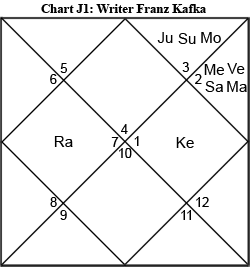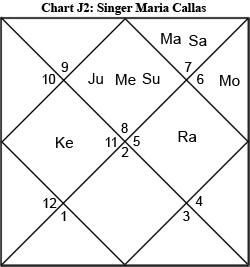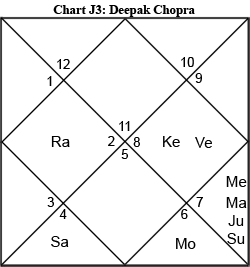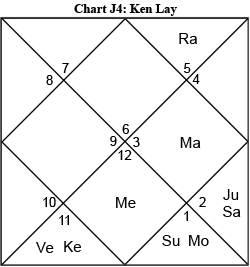| Free Jyotish Newsletter |
 Jyotish.ws
Jyotish.wsKala Sarpa: The Serpent of Time
By Deborah Allison
 Man's fascination with snakes spans continents, cultures and centuries. They have the elusive air of mystery, power, wisdom and menace. Countless myths, biblical references, ancient iconography and contemporary art feature these fascinating creatures. It is therefore not surprising that one of the most interesting and elusive yogas in Vedic Astrology is called the Kala Sarpa. Kala Sarpa can be translated as "the serpent of time" but also as a black snake, which could be a reference to the cobra.
Man's fascination with snakes spans continents, cultures and centuries. They have the elusive air of mystery, power, wisdom and menace. Countless myths, biblical references, ancient iconography and contemporary art feature these fascinating creatures. It is therefore not surprising that one of the most interesting and elusive yogas in Vedic Astrology is called the Kala Sarpa. Kala Sarpa can be translated as "the serpent of time" but also as a black snake, which could be a reference to the cobra.
The mystery begins with the fact that there are no references to the Kala Sarpa yoga in any of the classical Jyotisha texts (outside of some South Indian works). This is strange, considering that this yoga is very well known throughout India and regarded with awe and even fear. The Kala Sarpa seems to be embedded in the very consciousness of Indian culture with its rich history of legends, rituals and respect for the snake, a creature that is all too often encountered with suddenness and deadliness.
The mystery is deepened by the fact that there is no agreement about the exact formation of this yoga or even the results. One constant however, is that the yoga involves the entrapment of all of the grahas between Rahu and Ketu.
Rahu and Ketu are the shadow grahas that play a major role in the story of the restoration of the splendor of the devatas who were decimated by a curse levied on their King Indra by an irate rishi. They were advised to cooperate with the asuras and churn the unbounded ocean of creation so that the nectar of immortality would manifest, which would restore their luster and good fortune.
Rahu/Ketu was an asura, a serpent (what a surprise!). Being clever, cunning and adept at disguise, it managed to slip into the banquet where the devatas were dispensing the newly manifested nectar of immortality. Rahu, the head of the serpent, greedily drank the nectar and forgot to maintain its disguise. The Moon cried out to the Sun that an asura had crashed the banquet, and the Sun promptly threw its great discus and severed the serpent in half. Rahu the head and Ketu the tail became forever separated but immortal. They swore eternal revenge on the Sun and Moon and now lurk invisibly in the cosmos. When the luminaries come too close, Rahu swallows them and Ketu stings them. Fortunately, as Rahu and Ketu are cut in half, the Sun and Moon pass safely out into the empty space separating the severed asura. This is the Indian explanation of an eclipse—the grand illusion of shadows and the eternal dance between the light of the Sun and Moon. It represents the mysterious veil of the serpent.
If Rahu and Ketu have this power over the mighty luminaries, it is not too far a leap to think of the plight of the seven grahas trapped between the gaping mouth and venomous tail of the great Kala Sarpa. It is this image that gives rise to the dire predictions of doom and gloom for natives who have this configuration. However, it is also the case that some natives with this configuration have amazing blessings and a rise akin to that produced by raja yoga. Others experience both.
Let's look at a few charts for examples showing some of the variations we find for this combination. To begin with, there are two types of Kala Sarpa Yogas. One is when all of the seven grahas that are caught in the axis are moving toward the mouth of the serpent, Rahu. This is called anuloma and is considered the main formation. The other is when all of the planets are moving towards the tail Ketu and is known as viloma. Although the most exacting definition is that all seven should be in the houses between Rahu and Ketu, in some cases the yoga will fructify even if one or more grahas are posited in the same house as Rahu, Ketu or both.
 The dramatic and relatively short life of writer Franz Kafka in Chart J1 ("The Metamorphosis," "The Trial," "The Castle") is mirrored in the intense combinations in his remarkable chart. The Kala Sarpa Yoga shows all the grahas moving toward Rahu and is therefore an anuloma Kala Sarpa Yoga. It is set in a chart that has a striking combination of all of the seven planets in only two houses—a combination that is distinctly not favored by the shastra. In addition, the lagna lord Moon is at 0 degrees and in the 12th house. The only planet that aspects the ascendant is Saturn. Mercury and Venus are in a planetary war on the exact degree. There are certainly yogas which point to his pre-eminence and even posthumous fame but the remarkable afflictions in his life—both mental and physical—jump off the page while the RA/KE axis dominates a remarkable imbalance in the positioning of the grahas.
The dramatic and relatively short life of writer Franz Kafka in Chart J1 ("The Metamorphosis," "The Trial," "The Castle") is mirrored in the intense combinations in his remarkable chart. The Kala Sarpa Yoga shows all the grahas moving toward Rahu and is therefore an anuloma Kala Sarpa Yoga. It is set in a chart that has a striking combination of all of the seven planets in only two houses—a combination that is distinctly not favored by the shastra. In addition, the lagna lord Moon is at 0 degrees and in the 12th house. The only planet that aspects the ascendant is Saturn. Mercury and Venus are in a planetary war on the exact degree. There are certainly yogas which point to his pre-eminence and even posthumous fame but the remarkable afflictions in his life—both mental and physical—jump off the page while the RA/KE axis dominates a remarkable imbalance in the positioning of the grahas.
 The famous opera singer Maria Callas in Chart J2 is an excellent example of both the enormous rise and fall that the Kala Sarpa Yoga combination portends. This great diva has the viloma configuration with all the grahas moving towards Ketu. The huge rise of this immortal soprano is portended by the powerful yogas present in this chart. However, the seeds of an early demise and unhappiness in relationships is likewise seen by the lagna lord in the 12th in a planetary war with a very powerful Saturn that also aspects the 7th lord and karaka for marriage, Venus. This Kala Sarpa combination ignited all the yogas in the chart, but with the inherent weakness of the lord of the lagna, the yoga also helped manifest the great pathos and tragedies of her life.
The famous opera singer Maria Callas in Chart J2 is an excellent example of both the enormous rise and fall that the Kala Sarpa Yoga combination portends. This great diva has the viloma configuration with all the grahas moving towards Ketu. The huge rise of this immortal soprano is portended by the powerful yogas present in this chart. However, the seeds of an early demise and unhappiness in relationships is likewise seen by the lagna lord in the 12th in a planetary war with a very powerful Saturn that also aspects the 7th lord and karaka for marriage, Venus. This Kala Sarpa combination ignited all the yogas in the chart, but with the inherent weakness of the lord of the lagna, the yoga also helped manifest the great pathos and tragedies of her life.
 The chart of ayurvedic physician Deepak Chopra (Chart J3) also illustrates a viloma Kala Sarpa Yoga with some other remarkable combinations that pointed more in the direction of rise rather than suffering. In this chart, the Rahu side of the axis is joined by Venus. This gives a special spin to the outcome of this yoga. Venus is the lord of the 9th joining Rahu in a kendra, forming a dharma karma adhi pati yoga. It also participates in a dramatic and powerful parivartana yoga between the 9th lord Venus and the 10th lord Mars. This is simultaneously a raja yoga of the highest order. The chart also has a pravraja-like yoga of four planets together in one house. Here, it is in the 9th house which gives a huge focus on higher philosophy, knowledge, founding institutions, spiritual path and teaching.
The chart of ayurvedic physician Deepak Chopra (Chart J3) also illustrates a viloma Kala Sarpa Yoga with some other remarkable combinations that pointed more in the direction of rise rather than suffering. In this chart, the Rahu side of the axis is joined by Venus. This gives a special spin to the outcome of this yoga. Venus is the lord of the 9th joining Rahu in a kendra, forming a dharma karma adhi pati yoga. It also participates in a dramatic and powerful parivartana yoga between the 9th lord Venus and the 10th lord Mars. This is simultaneously a raja yoga of the highest order. The chart also has a pravraja-like yoga of four planets together in one house. Here, it is in the 9th house which gives a huge focus on higher philosophy, knowledge, founding institutions, spiritual path and teaching.
 Here is another chart (Ken Lay, Chart J4)where Venus joins one of the nodes, but this time it is with Ketu and in the 6th house, a dusthana compared to being in a kendra right at the mid-heaven. The whole disposition of this chart is dramatically different than that of the Chopra chart. There is also a Parivartana Yoga but this time it is between the 9th and the 6th. There are some strong yogas in this chart as well, speaking to Ken Lay's preeminence. His Rahu dasha brought downfall as the Kala Sarpa formation itself stretched across the difficult 6/12 axis with Rahu sitting in the 12th house. The Enron scandal broke in 2001 during RA dasha VE bhukti with both in 6/12. In contrast to the previous charts, SA aspects one end of the axis—in this case, the KE/VE side in the 6th house of enemies, disputes and lawsuits. The indictment came in the RA SU period which activated the 12th and 8th houses and the conviction and death in Rahu Mars once again activating the 12th and 8th with MA as lord of the 8th and most difficult planet for a Virgo lagna aspecting the ascendant. Mr. Lay would have been required to serve up to 25 years in prison but, he died at the age of 64 shortly before he was to be sentenced.
Here is another chart (Ken Lay, Chart J4)where Venus joins one of the nodes, but this time it is with Ketu and in the 6th house, a dusthana compared to being in a kendra right at the mid-heaven. The whole disposition of this chart is dramatically different than that of the Chopra chart. There is also a Parivartana Yoga but this time it is between the 9th and the 6th. There are some strong yogas in this chart as well, speaking to Ken Lay's preeminence. His Rahu dasha brought downfall as the Kala Sarpa formation itself stretched across the difficult 6/12 axis with Rahu sitting in the 12th house. The Enron scandal broke in 2001 during RA dasha VE bhukti with both in 6/12. In contrast to the previous charts, SA aspects one end of the axis—in this case, the KE/VE side in the 6th house of enemies, disputes and lawsuits. The indictment came in the RA SU period which activated the 12th and 8th houses and the conviction and death in Rahu Mars once again activating the 12th and 8th with MA as lord of the 8th and most difficult planet for a Virgo lagna aspecting the ascendant. Mr. Lay would have been required to serve up to 25 years in prison but, he died at the age of 64 shortly before he was to be sentenced.
In all the example charts, the Kala Sarpa Yoga delivered both sides of its potential, though the distribution of rise and fall differed dramatically. One of the distinguishing factors in terms of rise versus fall has to do with whether the Kala Sarpa Yoga was simultaneously tied in with other beneficial yogas and/or whether it was afflicted. Another critical factor, as always, is the all important strength of the lagna and lagna lord.
(c) copyright 2007 Michael Laughrin
From the October/November 2007 issue of Michael Laughrin's North American Jyotish Newsletter. Click to subscribe to this free Jyotish newsletter.
Read more articles.
Yagyas offered by Michael Laughrin.